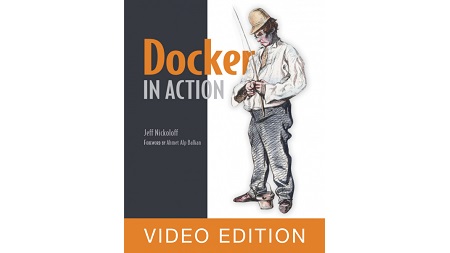
English | MP4 | AVC 1280×720 | AAC 44KHz 2ch | 10h 15m | 1.57 GB
Docker in Action teaches you how to create, deploy, and manage applications hosted in Docker containers. After starting with a clear explanation of the Docker model, you will learn how to package applications in containers, including techniques for testing and distributing applications. You will also learn how to run programs securely and how to manage shared resources. Using carefully designed examples, the book/course teaches you how to orchestrate containers and applications from installation to removal. Along the way, you’ll discover techniques for using Docker on systems ranging from dev-and-test machines to full-scale cloud deployments.
The idea behind Docker is simple. Create a tiny virtual environment, called a container, that holds just your application and its dependencies. The Docker engine uses the host operating system to build and account for these containers. They are easy to install, manage, and remove. Applications running inside containers share resources, making their footprints small.
Inside:
- Packaging containers for deployment
- Installing, managing, and removing containers
- Working with Docker images
- Distributing with DockerHub
To follow the book you need only have a working knowledge of the Linux OS. No prior knowledge of Docker is assumed.
Table of Contents
01 Welcome to Docker
02 Containers are not virtualization
03 What problems does Docker solve
04 Why is Docker important
05 Example – “Hello, World”
06 Running software in containers
07 Running interactive containers
08 Solved problems and the PID namespace
09 Eliminating metaconflicts – building a website farm
10 Container state and dependencies
11 Building environment-agnostic systems
12 Environment variable injection
13 Building durable containers
14 Keeping containers running with supervisor and startup processes
15 Cleaning up
16 Software installation simplified
17 Finding and installing software
18 Docker Hub from the website
19 Images as files
20 Installation files and isolation
21 Layer relationships
22 Benefits of this toolset and file system structure
23 Persistent storage and shared state with volumes
24 Using volumes with a NoSQL database
25 Volume types
26 Docker-managed volumes
27 Sharing volumes
28 The managed volume life cycle
29 Advanced container patterns with volumes
30 Data-packed volume containers
31 Network exposure
32 Docker container networking
33 Closed containers
34 Bridged containers
35 Opening inbound communication
36 Modifying the bridge interface
37 Joined containers
38 Inter-container dependencies
39 Environment modifications
40 Limiting risk with isolation
41 CPU
42 Shared memory
43 Understanding users
44 Users and volumes
45 Adjusting OS feature access with capabilities
46 Stronger containers with enhanced tools
47 Build use-case-appropriate containers
48 Packaging software in images
49 Reviewing file system changes
50 Going deep on Docker images and layers
51 Reintroducing images, layers, repositories, and tags
52 Exporting and importing flat file systems
53 Versioning best practices
54 Build automation and advanced image considerations
55 A Dockerfile primer
56 File system instructions
57 Injecting downstream build-time behavior
58 Using startup scripts and multiprocess containers
59 Building hardened application images
60 SUID and SGID permissions
61 Public and private software distribution
62 Publishing with hosted registries
63 Publishing public projects with automated builds
64 Introducing private registries
65 Manual image publishing and distribution
66 Image source distribution workflows
67 Running customized registries
68 Introducing the V2 API
69 Enhancements for centralized registries
70 Configuring HTTPS (TLS) on the reverse proxy
71 Adding an authentication layer
72 Client compatibility
73 Durable blob storage
74 Scaling access and latency improvements
75 Integrating through notifications
76 Declarative environments with Docker Compose
77 A complicated architecture – distribution and Elasticsearch integration
78 Iterating within an environment
79 Scale and remove services
80 Starting a new project – Compose YAML in three samples
81 Volume containers and extended services
82 Clusters with Machine and Swarm
83 Building and managing Docker Machines
84 Configuring Docker clients to work with remote daemons
85 Introducing Docker Swarm
86 Swarm extends the Docker Remote API
87 Swarm scheduling
88 Fine-tune scheduling with filters
89 Scheduling with BinPack and Random
90 Swarm service discovery
91 Looking forward to multi-host networking
Resolve the captcha to access the links!